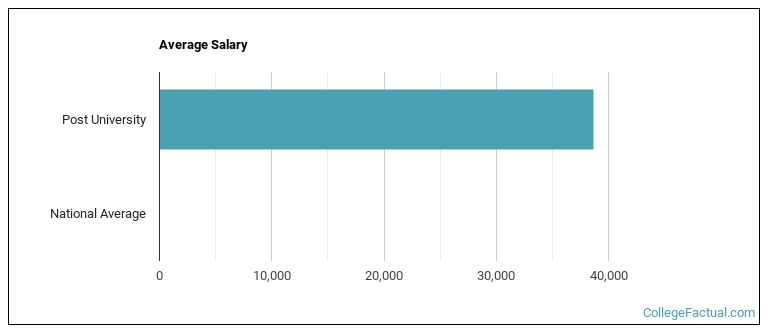 by our College Data Analytics Team
by our College Data Analytics TeamCollege Factual analyzes over 2,000 colleges and universities in its annual rankings and ranks them in a variety of ways, including most diverse, best overall quality, best for non-traditional students, and much more.
Post University was awarded 32 badges in the 2025 rankings. The highest ranked major at the school is general human services.
Explore the best ranked schools for the programs you are most interested in.
Post University is ranked #1,134 out of 2,152 schools in the nation for overall quality on College Factual's 2025 Best Colleges list.
Post University is also ranked #16 out of 18 schools in Connecticut.
If you are worried about getting into Post University, don't be. The school has a liberal open admissions policy, which means you only need to meet basic requirements in order to be admitted. Still, be sure to submit a complete application and provide any other requested materials.
The student to faculty ratio at Post University is about average at 16 to 1. This ratio is often used to gauge how many students might be in an average class and how much time professors will have to spend with their students on an individual level. The national average for this metric is 15 to 1.
Another measure that is often used to estimate how much access students will have to their professors is how many faculty members are full-time. The idea here is that part-time faculty tend to spend less time on campus, so they may not be as available to students as full-timers.
The full-time faculty percentage at Post University is 4%. This is lower than the national average of 47%.
The freshmen retention rate of 35% tells us that most first-year, full-time students don't stick around for a second year at Post University. Students may have a variety of reasons for this, such as only intending to attend a school for one year while they brush up on certain subjects.
The on-time graduation rate is the percent of first-time, full time students who obtain their bachelor's degree in four years or less. This rate is 18% for first-time, full-time students at Post University, which is lower than the national rate of 33.3%.
Find out more about the retention and graduation rates at Post University.
During the 2017-2018 academic year, there were 12,848 undergraduates at Post University with 3,609 being full-time and 9,239 being part-time.
| $0-30 K | $30K-48K | $48-75 | $75-110K | $110K + |
|---|---|---|---|---|
| $20,108 | $14,229 | $14,292 | $11,546 | $12,349 |
The net price is calculated by adding tuition, room, board and other costs and subtracting financial aid.Note that the net price is typically less than the published for a school. For more information on the sticker price of Post University, see our tuition and fees and room and board pages.
It's not uncommon for college students to take out loans to pay for school. In fact, almost 66% of students nationwide depend at least partially on loans. At Post University, approximately 92% of students took out student loans averaging $8,547 a year. That adds up to $34,188 over four years for those students.

Get more details about the location of Post University.

Contact details for Post University are given below.
| Contact Details | |
|---|---|
| Address: | 800 Country Club Rd, Waterbury, CT 06723 |
| Phone: | 800-345-2562 |
| Website: | www.post.edu/ |
| Most Popular Majors | Bachelor’s Degrees | Average Salary of Graduates |
|---|---|---|
| Nursing | 795 | NA |
| Business Administration & Management | 463 | $61,704 |
| Human Development & Family Studies | 297 | $31,627 |
| Criminal Justice & Corrections | 191 | $49,449 |
| General Business/Commerce | 189 | NA |
| Human Services | 138 | $41,124 |
| Bioethics/Medical Ethics | 121 | NA |
| Accounting | 118 | $59,213 |
| General Psychology | 89 | $31,377 |
| Legal Support Services | 80 | NA |
Online learning is becoming popular at even the oldest colleges and universities in the United States. Not only are online classes great for returning adults with busy schedules, they are also frequented by a growing number of traditional students.
In 2022-2023, 16,288 students took at least one online class at Post University. This is an increase from the 13,489 students who took online classes the previous year.
| Year | Took at Least One Online Class | Took All Classes Online |
|---|---|---|
| 2022-2023 | 16,288 | 15,984 |
| 2021-2022 | 13,489 | 13,026 |
| 2020-2021 | 13,094 | 12,709 |
| 2018-2019 | 9,003 | 8,769 |
If you’re considering Post University, here are some more schools you may be interested in knowing more about.
Curious on how these schools stack up against Post University? Pit them head to head with College Combat, our free interactive tool that lets you compare college on the features that matter most to you!
Footnotes
*The racial-ethnic minorities count is calculated by taking the total number of students and subtracting white students, international students, and students whose race/ethnicity was unknown. This number is then divided by the total number of students at the school to obtain the racial-ethnic minorities percentage.
References
More about our data sources and methodologies.